- Publisher's Note
- Editorial
- Guerrilla Girls: The Masked Culture Jammers of the Art World
- Creating for Change: Creative Transformations in Willie Bester’s Art
- Radioactivists -The Mass Protest Through the Lens
- Broot Force
- Reza Aramesh: Action X, Denouncing!
- Revisiting Art Against Terrorism
- Outlining the Language of Dissent
- In the Summer of 1947
- Mapping the Conscience...
- 40s and Now: The Legacy of Protest in the Art of Bengal
- Two Poems
- The 'Best' Beast
- May 1968
- Transgressive Art as a Form of Protest
- Protest Art in China
- Provoke and Provoked: Ai Weiwei
- Personalities and Protest Art
- Occupy, Decolonize, Liberate, Unoccupy: Day 187
- Art Cries Out: The Website and Implications of Protest Art Across the World
- Reflections in the Magic Mirror: Andy Warhol and the American Dream
- Helmut Herzfeld: Photomontage Speaking the Language of Protests!
- When Protest Erupts into Imagery
- Ramkinkar Baij: An Indian Modernist from Bengal Revisited
- Searching and Finding Newer Frontiers
- Violence-Double Spread: From Private to the Public to the 'Life Systems'
- The Virasat-e-Khalsa: An Experiential Space
- Emile Gallé and Art Nouveau Glass
- Lekha Poddar: The Lady of the Arts
- CrossOver: Indo-Bangladesh Artists' Residency & Exhibition
- Interpreting Tagore
- Fu Baoshi Retrospective at The Metropolitan Museum of Art
- Random Strokes
- Sense and Sensibility
- Dragons Versus Snow Leopards
- What Happened and What's Forthcoming
- Art Events Kolkata, February – March 2012
- Mumbai Art Sighting
- Art Bengaluru
- Delhi Dias
- Musings from Chennai
- Preview, March, 2012 – April, 2012
- In the News, March 2012
- Cover
ART news & views
In the News, March 2012
Issue No: 27 Month: 4 Year: 2012
‘No Wall’ Campaign by Cairo Street Artists
 Cairo. On March 9 activists and street artists invited Cairo’s residents to paint images of beauty on walls that might surpass the concrete barriers as part of the ‘No Wall’ campaign. Forced to live in communities disjointed by huge walls, a group of street artists have started the campaign and armed themselves with brushes and paint in an effort to transform the oppressive symbols into works of art.
Cairo. On March 9 activists and street artists invited Cairo’s residents to paint images of beauty on walls that might surpass the concrete barriers as part of the ‘No Wall’ campaign. Forced to live in communities disjointed by huge walls, a group of street artists have started the campaign and armed themselves with brushes and paint in an effort to transform the oppressive symbols into works of art.
Egypt has been wrecked with periodic outbursts of violence since the military took power in the wake of former President Hosni Mubarak’s downfall on February 11, 2011. In response to the violence, Egyptian authorities ordered that a number of streets surrounding government buildings in downtown Cairo be sealed off with massive concrete block walls.
Indian Art at Tel Aviv Museum of Art
 Tel Aviv. An exhibition titled Critical Mass is scheduled to take place at the Tel Aviv Museum of Art in May this year, which will display the works of 17 Indian artists.
Tel Aviv. An exhibition titled Critical Mass is scheduled to take place at the Tel Aviv Museum of Art in May this year, which will display the works of 17 Indian artists.
The exhibition would include both well-known artists and several emerging artists like Ravi Agarwal, Atul Bhalla, Sakshi Gupta, Shilpa Gupta, Subodh Gupta, Ranbir Kaleka, Rashmi Kaleka, Jitish Kallat, Bharti Kher, Riyas Komu, Raqs Media Collective, T V Santhosh, Gigi Scaria, Shanthamani M, Sudarshan Shetty, LN Tallur and Lochan Upadhyay.
The works are in a wide range of media including photography, painting, video, sculpture, and installation. They have many themes - tension between tradition and modernity, accelerated urbanisation and its impact on the environment, critique of consumer culture and globalization, religious tension and political conflicts, and gender-related issues.
The exhibition would be accompanied by a Hebrew-English catalogue that includes essays on Indian culture and on the major socio-political changes taking place in the sub-continent.
Eminent Artist Bijon Chowdhury Passes Away
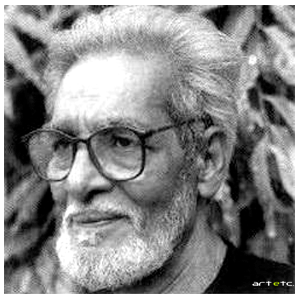
Kolkata. Eminent artist Bijon Chowdhury passed away on March 16, 2012. He was born in 1930 and was an ex- student of Government College of Arts and Crafts, Kolkata. He had participated in numerous exhibitions in India and abroad. In 1995 he was awarded the Abanindra Puroshkar by the Government of West Bengal. We lose yet another stalwart from the artist community.
Russian Artists Turn Anger to Art
Perm, Russia. As Prime Minister Putin seeks victory in the 4th March presidential election, Russian artists are reclaiming their long-dormant role of confronting authority and even people who don't claim to be artists are showing an imaginative streak.
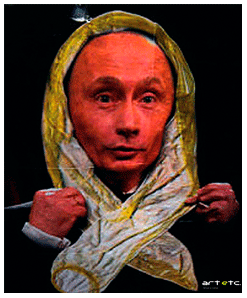 Under Soviet leader Mikhail Gorbachev and in the early years following the communist collapse, Russia's artists used their new freedom to provoke the powerful and make comment with paint, photographs and other media. But they lost momentum after Putin became president in 2000, partly out of fear of a newly repressive climate, partly succumbing to apathy. And the increasingly lucrative potential for going commercial dampened cutting edge artists' enthusiasm for tackling politics. The protest rallies over the past few months have been marked by a high level of satirical art, both in placards and performances. Angered by Putin's contemptuous comment that the protesters' white-ribbon emblems looked like condoms, demonstrators have found unlimited fun with the theme. One notable placard showed Putin with a condom wrapped around his head, in the style of headscarves widely worn by Russian rural women.
Under Soviet leader Mikhail Gorbachev and in the early years following the communist collapse, Russia's artists used their new freedom to provoke the powerful and make comment with paint, photographs and other media. But they lost momentum after Putin became president in 2000, partly out of fear of a newly repressive climate, partly succumbing to apathy. And the increasingly lucrative potential for going commercial dampened cutting edge artists' enthusiasm for tackling politics. The protest rallies over the past few months have been marked by a high level of satirical art, both in placards and performances. Angered by Putin's contemptuous comment that the protesters' white-ribbon emblems looked like condoms, demonstrators have found unlimited fun with the theme. One notable placard showed Putin with a condom wrapped around his head, in the style of headscarves widely worn by Russian rural women.
The amateur creations delighted artists, but also left many feeling sheepish about having abandoned political themes. Creative protest has penetrated so deep into Russian society that even some seemingly frivolous figures have come up with clever forms of dissent.
Yoko Ono Wins the 2012 Oscar Kokoschka Prize
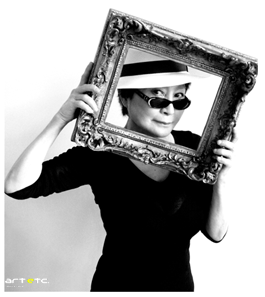
Vienna. Yoko Ono has won the 2012 Oscar Kokoschka prize, Austria's highest award for applied contemporary art. The Tokyo-born widow of Beatle John Lennon is Now 79. She is an avant-garde artist who has shot a number of experimental films and has been involved in writing music and singing. The Oskar Kokoschka prize, named after an Austrian painter who died in 1980, is awarded every two years to a contemporary artist and is worth 20,000 euros ($26,600).
Sculpture Recovered After 16 Years Theft

Ottawa. A 16-year-old mystery about the fate of a beautiful $500,000 bronze whale sculpture by renowned Canadian artist Bill Reid was solved. The piece by Reid, whose work adorns the $20 bill and various Canadian landmarks, had been stolen from an Ottawa park in 1995 and was never seen again until Lorraine Pierce-Hull, who works for the National Capital Commission, the government body responsible for beautifying Canada capital got a call from Ottawa police.
The Ottawa Police are being tight-lipped about who had the statue and how he got it.
The police are calling for more tips, but for now, officials at the NCC are just happy to have their whale back.
Ai Weiwei’s Sunflower Seeds Bought by the Tate Modern
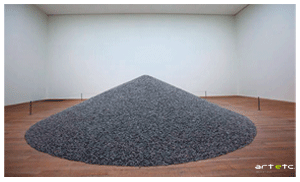 London. The Tate has acquired approximately 8m individual sculptures, its largest number of works of art ever, although each is smaller than a little finger nail: 10 tonnes of Ai Weiwei's famous porcelain sunflower seeds.
London. The Tate has acquired approximately 8m individual sculptures, its largest number of works of art ever, although each is smaller than a little finger nail: 10 tonnes of Ai Weiwei's famous porcelain sunflower seeds.
Sunflower Seeds 2010, the work that the Tate has bought, represents less than a 10th of the 100m seeds, all individually sculpted and painted by Chinese craft workers, used for the installation. The Tate acquired the work with the help of a grant from the Art Fund charity. A quantity of the seeds were sold at a Sotheby's auction last year, soared above the top estimate and ended up at £3.50 a seed.
Berlin Museum to Return Art Seized By Nazis
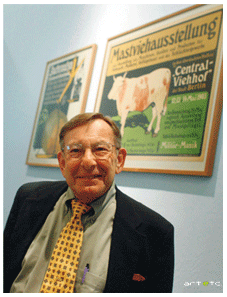 Berlin. Germany’s top federal appeals court, The Federal Court of Justice in Karlsruhe, ruled on March 16 that the German Historical Museum must return thousands of rare posters to an American, Peter Sachs, 74, part of his Jewish father's unique collection that had been seized by the Nazis.
Berlin. Germany’s top federal appeals court, The Federal Court of Justice in Karlsruhe, ruled on March 16 that the German Historical Museum must return thousands of rare posters to an American, Peter Sachs, 74, part of his Jewish father's unique collection that had been seized by the Nazis.
Sachs the rightful owner of the posters owned by his father Hans, ending seven years of legal battles over a vast collection dating back to the late 19th century. A total of 4,259 posters have been identified so far as having belonged to Sachs' father. They were among a collection of 12,500 that his father owned, which include advertisements for exhibitions, cabarets, movies and consumer products, as well as political propaganda -- all rare, with only small original print runs. The collection is now believed to be worth between C4.5 million and C16 million ($6 million and $21 million).
The posters were collected by Sachs, stolen from him by the Nazis' Gestapo, became the possession of communist East Germany for decades, and then moved to the Berlin museum after Germany's reunification in 1990.
Born in 1881, Hans Sachs was a dentist who began collecting posters while in high school. By 1905, he was Germany's leading private poster collector and later launched the art publication Das Plakat (The Poster). The posters became part of the German Historical Museum's collection in 1990 after the 1989 fall of the Berlin Wall.
Free Art for Fair Exchange at the Armory Show
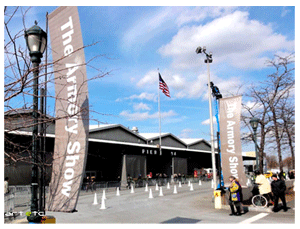 New York. On March 10 and 11 Occupy Museums invited all artists and non-artists to join a mobile exchange art fair on the sidewalk outside of the Armory Show in New York City. Participants were encouraged to bring items such as paintings, drawings, sculpture, conceptual art, crafts, food, and other objects to exchange with Armory attendees and each other.
New York. On March 10 and 11 Occupy Museums invited all artists and non-artists to join a mobile exchange art fair on the sidewalk outside of the Armory Show in New York City. Participants were encouraged to bring items such as paintings, drawings, sculpture, conceptual art, crafts, food, and other objects to exchange with Armory attendees and each other.
Booths at this fair were free of charge. The Armory Show was initiated in 1994.
The Tower of Protest Being Rebuilt
New York. Artists' Tower of Protest (also known as the Peace Tower) was the first major artist-organized protest against the Vietnam War anywhere in the United States. First conceived and constructed in 1966, the Peace Tower was an art installation by Mark di Suvero and others. The 58-foot steel tetrahedron tower surrounded by hundreds of art panels was erected on a lot on the corner of Sunset and La Cienega boulevards in 1969 as a symbol of collective dissent against the Vietnam War. It mobilized artists from across Southern California, and it also featured work by artists from around the world. Forty years later, di Suvero collaborated with Rirkrit Tiravanija to construct a new installation, called Peace Tower (2006) at the Whitney Museum of American Art in New York City to protest the Iraq War.
Los Angeles-based painter, performance and installation artist Doni Silver Simons has contributed a panel to the Artists' Tower of Protest. The panel seeks to raise awareness of human rights crimes against Darfuri and Congolese women and children. For the panel, Silver Simons superimposed three different images on a metal plates, the first, her painting From the Archives; the second, a photograph of a ‘prayer drawing’ created by a young Congolese victim of violent crime; and the third, an inscription written by a Congolese woman.
The Tower of Protest Being Rebuilt
 New York. Artists' Tower of Protest (also known as the Peace Tower) was the first major artist-organized protest against the Vietnam War anywhere in the United States. First conceived and constructed in 1966, the Peace Tower was an art installation by Mark di Suvero and others. The 58-foot steel tetrahedron tower surrounded by hundreds of art panels was erected on a lot on the corner of Sunset and La Cienega boulevards in 1969 as a symbol of collective dissent against the Vietnam War. It mobilized artists from across Southern California, and it also featured work by artists from around the world. Forty years later, di Suvero collaborated with Rirkrit Tiravanija to construct a new installation, called Peace Tower (2006) at the Whitney Museum of American Art in New York City to protest the Iraq War.
New York. Artists' Tower of Protest (also known as the Peace Tower) was the first major artist-organized protest against the Vietnam War anywhere in the United States. First conceived and constructed in 1966, the Peace Tower was an art installation by Mark di Suvero and others. The 58-foot steel tetrahedron tower surrounded by hundreds of art panels was erected on a lot on the corner of Sunset and La Cienega boulevards in 1969 as a symbol of collective dissent against the Vietnam War. It mobilized artists from across Southern California, and it also featured work by artists from around the world. Forty years later, di Suvero collaborated with Rirkrit Tiravanija to construct a new installation, called Peace Tower (2006) at the Whitney Museum of American Art in New York City to protest the Iraq War.
Los Angeles-based painter, performance and installation artist Doni Silver Simons has contributed a panel to the Artists' Tower of Protest. The panel seeks to raise awareness of human rights crimes against Darfuri and Congolese women and children. For the panel, Silver Simons superimposed three different images on a metal plates, the first, her painting From the Archives; the second, a photograph of a ‘prayer drawing’ created by a young Congolese victim of violent crime; and the third, an inscription written by a Congolese woman.
Chinese Architect Wins Pritzker Prize
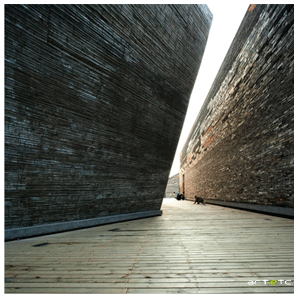 China. Hyatt Foundation of Chicago announced on 27 February that Wang has won the 2012 Pritzker Architecture Prize. He will receive $100,000 and a bronze medallion in May in Beijing.
China. Hyatt Foundation of Chicago announced on 27 February that Wang has won the 2012 Pritzker Architecture Prize. He will receive $100,000 and a bronze medallion in May in Beijing.
He also heads the architecture department of the China Academy of Art in Hangzhou and with his wife, architect Lu Wenyu, he runs firm called Amateur Architecture Studio in Hangzhou, southwest of Shanghai.
Some of Wang’s buildings make an awkward first impression; they seem not so much designed as improvised. Wang’s History Museum in Ningbo looks like an ancient fortress, with tilting walls that appear eroded by centuries. Up close the walls look weathered because they are exquisitely composed of worn salvaged stones and old arched roof tiles that alternate the predominant gray with bright orange patches of squiggly terra cotta.
Wang, in a series of idiosyncratic works, has attempted to help Chinese realize what they are erasing. His answer to the wholesale destruction of historic Chinese cities is to collect the stones of demolished buildings and install them in new ones.
5 Auction Houses and 17 Museums Collaborate for the Asia Week New York 2012

New York. Asian art specialists, 5 auction houses, and 17 museums and Asian cultural institutions in New York collaborated for the Asia Week New York 2012. The Asia Week New York 2012 started on March 16 and continued till March 24, 2012. Exhibitions were presented by more than 30 prominent Asian art dealers from the U.S. and abroad, auctions at, Bonhams, Christie’s, Doyle New York, iGavel, and Sotheby’s as well as dozens of special events were organised. All exhibitions, auctions, and events were listed in a comprehensive 80-page guide with maps, available at the participating galleries, auction houses and cultural institutions.